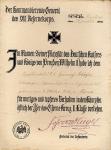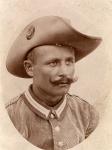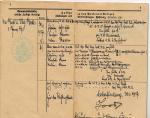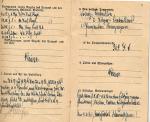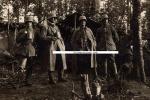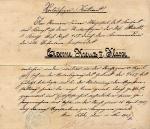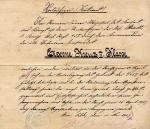-
Posts
29,250 -
Joined
-
Last visited
-
Days Won
84
Content Type
Profiles
Forums
Blogs
Gallery
Events
Store
Everything posted by Chris Boonzaier
-

EK 1914 The Devil on the Mountain
Chris Boonzaier posted a topic in Germany: All Eras: The Iron Cross
I would really like to visit this bit of battlefield someday... I did an article about it here... http://www.kaiserscross.com/40047/41106.html Anf just got some stuff to another guy who fought in Height 185... -
Then, the Militärpass for a guy buried alive at Thiaumont Farm (Verdun) in mid June 1916. I have walked that area many, many times. He seems to have been so effected by the occurance that after a spell in hospital he was released to work (at a tailors?) The Militärpass was issued by the Ersatz Battalion in Aschaffenburg
-
Realistically the end of war figures of divisions crushed. captured and destroyed mean nothing at all. I have not read up on all sectors but did a bit of research on some units in the Meuse Argonne sector in October-November due to a German Tunic I have named to an officer in an Infantry Regiment that "fought" there. He belonged to one of the crushed divisions. When you read the regt histories of the division, they did not really bother to do much fighting at this stage, they were there... but not too active, unless noone bothered to enter things into the regt diary. It serves no purpose (IM as always HO) to compare any late 1918 stats to any other period in the war. From September to November in some sectors the problem was not that you had to fight the Germans, but rather finding Germans worthy of fighting. That may be why Canadians who served in WW1 made more of Vimy than the last 100 days. (Try and find a German Regt history that mentions any real fighting this late. They are few and far between).
-

EK 1914 Sexiest EK doc of the week?
Chris Boonzaier replied to Chris Boonzaier's topic in Germany: All Eras: The Iron Cross
Seems a VC was won in that action as well... http://en.wikipedia.org/wiki/Edward_Foster_%28VC%29 -
-

EK 1914 Sexiest EK doc of the week?
Chris Boonzaier posted a topic in Germany: All Eras: The Iron Cross
-

France Foreign Legion Member in the Great War
Chris Boonzaier replied to Mark Brewer's topic in France
Hi, here you go... http://www.nzherald.co.nz/nz/news/article.cfm?c_id=1&objectid=10800634# -

France Foreign Legion Member in the Great War
Chris Boonzaier replied to Mark Brewer's topic in France
He stands arguably as New Zealand's greatest war hero alongside Sir Charles Upham - even though he fought for the French Foreign Legion. But, as Paul Charman writes, the life and times of secretive Gallipoli hero James Waddell are celebrated more overseas and are proving difficult even to make into a book He was a pint-sized Kiwi warrior who commanded French Foreign Legion troops at Gallipoli and became one of the most decorated combat soldiers of the Great War. However, efforts to showcase James Waddell's incredible exploits are so far being frustrated. Film-maker Jasmine Pujji says few New Zealanders know anything about Waddell's remarkable story - but it's high time they did. The saddler's son from Dunedin won the Croix de Guerre eight times and retired as Commander of the French Legion of Honour. Waddell came to Pujji's attention in 2009. She has worked on three of Maori Television's Anzac Day broadcasts and has been trying to piece together his life story ever since. But, last year, the Ministry of Culture and Heritage turned down her application to fund a book on Waddell, the proposed first step in making a film. Meanwhile, the French Embassy plans to feature him prominently this Armistice Day and during 100-year commemorations of World War I, in 2014. French Ambassador Francis Etienne rates Waddell's service to France alongside that of New Zealander Nancy Wake, the so-called "White Mouse", who was a British agent in occupied France during World War II. "I am surprised there has not been a book or a documentary - we would certainly look at providing help for such a venture," says Etienne. "To me he was such a remarkable guy. He overcame so many difficulties, moved around the world in an era when travel was difficult, made a great contribution through his military leadership and rose to a high position in society. What a story to tell young people today." But those seeking to tell Waddell's story have their work cut out. Even surviving grandchildren remember little about the larger-than-life colonel, who stood just 1.6m (5ft 4in) tall. Part of the fault seems to have been Waddell's. During his lifetime he shunned publicity so carefully that little about him seems to have been written down. We know he was subjected to intense bullying in the British Army then thrived in the French Foreign Legion after marrying a French woman who persuaded him that the French army was a better bet. He had charisma as a commander and - as he was married three times - probably also some charm with the ladies. Growing up in 19th century Dunedin, the young Waddell was, in the words of his parents, "fair dinkum mad on soldiering as a boy", an obsession his surviving grandchildren say was helped by having an infamous great uncle in the American Civil War. James Iredell Waddell captained the Confederate cruiser Shenandoah, which controversially attacked the United States-flagged whaling fleet in the South Atlantic weeks after the war had ended - because of poor communications at the time. By the age of 19, the captain's nephew had studied for and gained a commission in the Duke of Wellington Regiment. Young Waddell sailed from Christchurch to Natal, South Africa, in 1896, just before the Boer War. He landed without money or friends and as the sole colonial among the sons of English gentry. It was an unhappy union. Over many months his fellow junior officers harassed and humiliated him, demanding he quit the regiment. He was beaten up, stripped naked, marched around the camp with his hands bound and humiliated before enlisted ranks. He was different. He was a colonial with no class status and no money. The other subalterns made it clear he didn't fit in and bullied him so he would leave. His property was destroyed and his rooms ransacked, the attacks becoming so intense that at one point Waddell was forced to draw his sword to defend himself. But Waddell had grit. He refused to move on. When the extent of the bullying came to light, it set Britain's Colonial Office at odds with the Seddon Government in New Zealand. It was feared that if word got out, young colonials would hesitate to enlist to fight for the Mother Country. The five subalterns who tormented Waddell were eventually censured. After his regiment was transferred to India, Waddell fell in love with and married a French woman, who persuaded him that the French army would be more democratic. Her relatives helped him to join the Legion in Algeria, at the rank of lieutenant. Waddell spent many years soldiering round the world but his career took off when, in his early 40s, he found himself commanding battalions on the great battlefields of World WarI. He formulated and led many audacious attacks, always leading from the front, and seemingly able to inspire men to follow him against impossible odds. One lightning raid he led on the Western Front captured many German guns and prisoners, with few Legionnaire casualties. His commanders had been adamant that the position must not be attacked but Waddell was equally confident that it could be taken, saying he knew his men. The victory gained Waddell another palm for his Croix de Guerre - but had he failed he would have been court-martialled and shot. His exploits in Gallipoli were also remarkable. A Legion battalion arrived at Cape Helles, Gallipoli, on April 28, 1915, three days after the initial landings. Casualties were heavy. There were three pitched battles in June and July. The first of Waddell's citations came after he commanded the Legion battalion in a frontal attack which captured Turkish-held trenches. Four days later he was promoted to major. His Gallipoli campaign ended when he was badly wounded leading his battalion in another successful attack. He was hit by shrapnel in one shoulder and by a bullet in the other but refused to leave until the next day when he was satisfied that the defence of the captured position had been organised. Repatriated to France, Waddell was soon in action again - with a Legion battalion on the French front in October 1915. HISTORIAN DAVID Scoullar, a retired Wanganui Chronicle journalist, has researched the inquiry into Waddell's ill treatment in the British army and his career in the Legion. He rates Waddell's very survival as astonishing. "Waddell had postings including hot spots in Algeria, the Sahara, Morocco, China and two terms (seven years) in Vietnam. Considered among the best tactical commanders produced at the time by the Legion, he fought at Gallipoli, on the major battlefields of France. By the end of the war, 43,000 men had served in the Legion, while its casualties numbered 31,000 but, despite being wounded three times, somehow Waddell came through it all." Following this brilliant service, he transferred to the French army, which culminated in him being appointed a governor in occupied Germany. He later retired to his farm in Tunisia. In later life he was apparently among the wealthy and privileged, says a granddaughter, Claudia Klein of Tauranga. "From what little we know, grandfather was no stranger to French high society; we believe he associated with White Russian and French aristocrats." Yet, when he slipped back into his native country aboard a passenger ship in 1950, Waddell snubbed a phalanx of reporters gathered on the dock. He settled with his son and daughter-in-law in Tauranga and lived there quietly before visiting a son in Levin in 1954. There, he fell seriously ill but was visited several times before he died by an evangelist named Enoch Coppin. Coppin wrote that Waddell shared his life story only after fixing the preacher with a searching glance, raising a finger, and saying, "no reporters, please". From these conversations Coppin wrote Victory Forever, a tract based on Waddell's life and dramatic conversion. Outside of a few newspaper articles, it is the only attempt by a New Zealander to record Waddell's life - although, as he led many of the Americans who served with the Legion, he figures prominently in books recalling their service. Pujji says telling Waddell's life story properly would demand research in New Zealand and the Francophone countries he was stationed in. She says time is fast running out for such a venture, as even the children of those who knew Waddell are now well advanced in years. "This intriguing character totally broke the mould as a Kiwi embedded in the senior ranks of the French Foreign Legion. His career coincided with some of most momentous conflicts of the last 150 years - he was a great soldier and seemed to be everywhere. But we'd all love to know more about the man behind the soldier." -
An interesting review... You could learn a lot about Canada’s national psyche from the country’s enduring fascination with the battle of Vimy Ridge, fought 95 years ago this past week. Canadians fought dozens of major battles during the First World War. Yes, Vimy was the most tactically spectacular: One of the best-planned, best-executed Allied operations of the whole war. Vimy fully deserves the honour it carries in the national memory. But the exclusive attention to Vimy obscures other Canadian achievements even more deserving of honour. Who remembers now the Battle of Amiens in August, 1918? Yet it was this battle that broke the spirit of the German Army in the West. German troops broke and ran before a Canadian and Australian-led assault: the first German rout of the war. Between August and November, Canadians spearheaded a sequence of attacks that destroyed the German army’s will to fight. <a name="body_text_4" style="visibility:hidden"> Those battles — collectively known as the Hundred Days — have been brilliantly summarized in a short book that, if it were up to me, would be assigned to every high school student in Canada: Shane Schreiber’s Shock Army Of The British Empire. By Schreiber’s tally, the 100,000 Canadians who fought in the Hundred Days met almost one-quarter of the entire remaining German army on the Western Front: Forty-seven German divisions against four Canadians. The Canadian forces fought alongside an Australian/New Zealand contingent. The three Dominions together engaged some 40% of the German army. ...... Being a Canadian, of course, Schreiber underscores his point with a final statistical comparison to the U.S. forces in the Meuse-Argonne region on the southern portion of the Western front. Troops engaged Americans: 650,000 Canadians: 105,000 Duration of Operations Americans: 47 days Canadians: 100 days Maximum Distance Advanced Americans: 34 miles Canadians: 86 miles German Divisions Defeated (out of a total of 200) Americans: 46 Canadians: 47 Average Number of Casualties Suffered per German Division Defeated Americans: 2,170 Canadians: 975 Total Casualties Americans: 100,000 Canadians: 45,830 Full article... http://fullcomment.nationalpost.com/2012/04/14/david-frum-going-beyond-vimy/
-

"What's New" at Kaiserscross.com
Chris Boonzaier replied to Chris Boonzaier's topic in The Great War 1914 to 1918
Some cool new stuff up.... http://www.kaiserscross.com/152301.html -

Freikorps Documents
Chris Boonzaier replied to Chris Boonzaier's topic in Germany: Weimar Republic & Deutsche Freikorps
-

Freikorps Documents
Chris Boonzaier replied to Chris Boonzaier's topic in Germany: Weimar Republic & Deutsche Freikorps
Here is a card for ex members of the Iron Division.... -

Freikorps Documents
Chris Boonzaier replied to Chris Boonzaier's topic in Germany: Weimar Republic & Deutsche Freikorps
Nice Andreas!!



